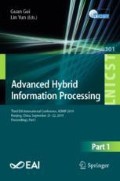Abstract
In order to guide the traffic organization in the ancient building group in an orderly manner, the simulation study on the pedestrian road planning of the ancient building group in the cloud computing environment is proposed. Based on the analysis of the characteristics of pedestrian roads, a cloud computing environment road planning simulation model is established. Using the cloud computing environment to determine the maximum number of people on the road, use the simulation software LEGION to set the structure and parameters of the model, and carry out road planning and deduction in the simulator to realize the design of the road planning simulation model. Through the method of experimental argumentation and analysis, the effectiveness of the cloud computing environment road planning simulation model is determined, which can improve the order planning of pedestrians’ road planning.
Access this chapter
Tax calculation will be finalised at checkout
Purchases are for personal use only
References
Zhang, Y., Wang, X., Liu, X., et al.: Summary of cloud computing environmental security. J. Softw. 27(6), 1328–1348 (2016)
Gazilla, H.: Data security in large data cloud computing environment. Electron. Technol. Softw. Eng. 52(15), 173–174 (2017)
Sun, S.: Evaluation of pedestrian road friendliness based on attribute measure. Stat. Decis. 1, 56–59 (2017)
Su, J.: Discussing the design of landscape roads in landscape planning. China Sci. Technol. Investment 52(29), 101–103 (2016)
Yuan, J.: Pedestrian traffic flow model and road section performance evaluation method. Hunan Traff. Sci. Technol. 42(3), 198–200 (2016)
Hong, Y., Ye, P., Zhu, C., et al.: Research on pedestrian traffic prediction in nanning garden expo. Prose Baijia (New Lang. Loop Page) 65(4), 89–91 (2016)
Tian, C.: Analysis of key issues to be considered in the planning and design of municipal roads. Archit. Eng. Technol. Des. 56(8), 203–205 (2016)
Su, S., He, L.: Transient dynamic congestion evacuation model for pedestrians at pedestrian traffic planning intersection. J. Jilin Univ. (Eng. Ed.) 48(2), 440–447 (2018)
Li, J.: Probe into urban road traffic planning and design. Commod. Qual. 17(6), 49–51 (2016)
Li, J.: Strategies on urban traffic road planning and design. Charm China 19(31), 91–92 (2016)
Kong, A.: A brief talk on planning and design of urban pedestrian stereo crossing road—taking planning and design of pedestrian stereo crossing road in Shaoxing City as an example. Eng. Constr. Des. 36(6), 52–56 (2018)
Luo, C.: Planning for the protection of ancient buildings in urban development—taking the planning for the protection of ancient buildings in Zhoucun street as an example. Eng. Technol.: Citation Ed. 10(2), 103–105 (2017)
Li, Y.: Non-continuous hierarchical data mining method based on cloud computing. J. Xi’an Polytech. Univ. 4, 498–503 (2017)
Yin, H.: Numerical simulation of pedestrian wind environment in high-rise buildings. Urban Build. 26(2), 215–217 (2017)
Acknowledgments
1. Research on the Classification, Conservation and Utilization of Historic buildings and blocks, supported by the Scientific Research Grant Project of institutions of higher Learning in Inner Mongolia Autonomous region (Project Plan No. NJZY18255).
2. Research on adaptation Strategy of Rural Housing in Hohhot, a scientific research grant project for colleges and universities in Inner Mongolia Autonomous region (Project Plan No. NJZY18257).
3. Study on the Conservation and Utilization in the Planning of Historic blocks in the Desert-Southern Mongolia area-taking Wulanchabu area as an example (Grant No: 18NDXT02).
This achievement is supported by the Cooperative Innovation Center for Cultural inheritance and Development of Mongolian and Northern Minority nationalities in Inner Mongolia Autonomous region.
Author information
Authors and Affiliations
Corresponding author
Editor information
Editors and Affiliations
Rights and permissions
Copyright information
© 2019 ICST Institute for Computer Sciences, Social Informatics and Telecommunications Engineering
About this paper
Cite this paper
Qiao, Em., Shang, Dw. (2019). Simulation Study on Pedestrian Road Planning in Ancient Building Groups Under Cloud Computing Environment. In: Gui, G., Yun, L. (eds) Advanced Hybrid Information Processing. ADHIP 2019. Lecture Notes of the Institute for Computer Sciences, Social Informatics and Telecommunications Engineering, vol 301. Springer, Cham. https://doi.org/10.1007/978-3-030-36402-1_38
Download citation
DOI: https://doi.org/10.1007/978-3-030-36402-1_38
Published:
Publisher Name: Springer, Cham
Print ISBN: 978-3-030-36401-4
Online ISBN: 978-3-030-36402-1
eBook Packages: Computer ScienceComputer Science (R0)

